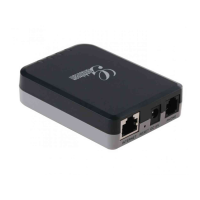HT70X User manual
Version 1.0.9.4
Use STUN to detect
network
connectivity
Use STUN keep-alive to detect WAN side network problems. If keep-alive request
does not yield any response for configured number of times, the device will restart
the TCP/IP stack. If the STUN server does not respond when the device boots up,
the feature is disabled. Default setting is No.
Use DNS to detect
network
connectivity
Use DNS to detect WAN side network problems. Default setting is Yes.
Firmware Upgrade
and Provisioning
Enables HT70X to download firmware or configuration file through either the TFTP,
HTTP or HTTPS server.
This is the IP address of the configured TFTP server. If selected and it is non-
zero or not blank, the HT70X retrieves the new configuration file or new code
image from the specified TFTP server at boot time. After 5 attempts, the system
will timeout and will start the boot process using the existing code image in the
Flash memory. If a TFTP server is configured and a new code image is retrieved,
the new downloaded image is saved into the Flash memory.
Note: Please do NOT interrupt the TFTP upgrade process (especially the power
supply) as this will damage the device. Depending on the local network, this
process can take up to 15 or 20 minutes.
The URL for the HTTP/HTTPS server used for firmware upgrade and configuration
via HTTP.
For example,
http://provisioning.mycompany.com:6688/Grandstream/1.0.0.67“:6688” is the
specific TCP port where the HTTP or HTTPS server is listening; it can be omitted
if using default port 80.
Note: If Auto Upgrade is set to No, HT70X will only do HTTP/HTTPS download
once at boot up.
IP address or domain name of firmware server.
IP address or domain name of configuration server.
The password used for encrypting the XML configuration file using OpenSSL.
This is required for the phone to decrypt the encrypted XML configuration file.

